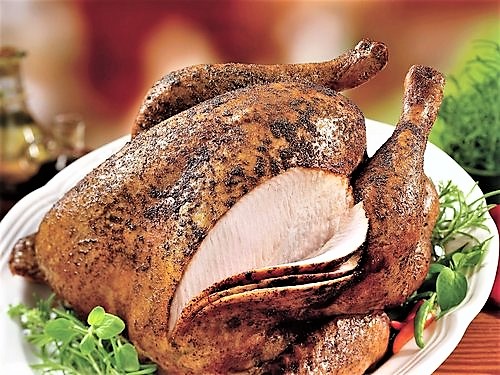It seems deep fried turkeys are a holiday must these days. Believe it or not, the one-pot cooking method is not a new culinary sensation. It has been around for eons and got its Louisiana Cajun country roots in the late 80’s and 90’s.
As more and more folks fry turkeys especially during Thanksgiving and Christmas, the stories of horrific accidents involving the process has increased as well. Tales of houses being burned down, serious hot oil burn injuries, and even turkey-based explosions have occured involving turkey frying. But if the process is done right and handled safely, the end result will be a crispy, moist and scrumptious bird.
There are a few tips to take note of before you drop the bird in hot oil:
A smaller bird is best. A 10 to 12-pounder does better in a fryer. A larger turkey has to cook longer so there is a greater chance of burning the oil.
Never exceed the maximum fill line of a fryer and preheat the oil according to its manufacturer’s suggestion.
Pat your bird dry inside and out with paper towel, then prepare it as desired with dry seasonings and or an injection of marinades. Word to the wise…do not inject the marinade just under the skin as a water-based marinade will result in the hot oil popping and splattering. Remember to remove the pop-up timer from the breast (if applicable). Do not stuff your turkey with dressing!
Propane turkey fryers must be used outdoors and placed on level dirt or on a grassy area. Never place a propane unit on a wooden deck which could catch fire, or on concrete which can be stained by the oil.
An indoor electric turkey fryer may be placed on a countertop that is a sensible distance from overhead cabinets.
Never just plop a turkey into hot oil, slowly lower it to prevent splattering. Be sure to wear long oven mitts on your hands and sport long sleeves to avoid splattering hot oil on your skin
Speaking of oil, peanut works best because it has the smoke point. If there is a nut allergy, you can get away with canola.
According to the Texas Peanut Producers Board, peanut oil may be used three or four times to fry turkeys before signs of deterioration begin. Such indications include foaming, darkening or smoking excessively, indicating the oil must be discarded. Other signs of deteriorated oil include a rancid smell and/or failure to bubble when food is added.
Once you’re done frying your bird remove it from the fryer and check its internal temperature with a food thermometer. The internal temperature should be 165°F to 170°F in the breast and 175°F to 180°F in the thigh.
One last tip, keep a watchful eye on your fryer, NEVER leave it unattended during the heating, cooking and cooling process!
Now here’s a fried turkey recipe that is so good it will make you wanna smack yo mama!
Ingredients:
- 5 tablespoons onion powder
- 5 tablespoons garlic powder
- 5 tablespoons salt
- 3 tablespoons red pepper flakes
- 1 tablesppon of black pepper
- 4 tablespoons smoky paprika
- 2 tablespoons ground oregano
- 2 tablespoons Italian seasoning
- 1 cup of butter
- 3 gallons peanut oil
- One 10 to 12 pound turkey, thawed
Equipment:
- 1 propane-fueled turkey fryer
- 1 meat injector
- 1 basting brush
Instructions:
- Pour peanut oil into fryer up to the maximum fill line
- Heat peanut oil until temperature reaches 350 degrees F. or as per manufacturer’s suggestion
- Combine spices in a bowl
- Melt butter in a saucepan
- Combine butter and spices
- Fill the meat injector with the butter mixture
- Pull the skin back from the breast meat, and deeply inject the butter spice mixture into several areas of the turkey
- Repeat this process 2 to 3 times
- Rub the remaining butter mixture inside and outside of the turkey
- Carefully lower the turkey into the hot oil, make sure to fully submerge it
- Fry turkey for 3 minutes per pound, plus an extra 5 minutes per bird
- Remove turkey from fryer, drain on paper towels. Allow the bird to rest for at least 15 minutes, then carve and serve.
